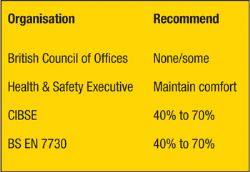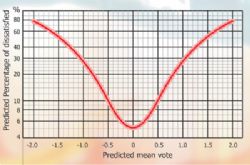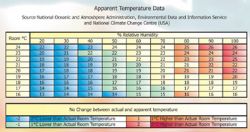Masterclass author Mike Creamer.
Regulations
There is a woolly area surrounding the regulations and recommendations of the operating conditions for humidification leading to a 'comfort controlled environment' we need to clarify the difference between regulation and recommendation as a means of proportioning ownership.
The Oxford English Dictionary states that to regulate means 'control by rule', 'subject to restriction', 'adapt to requirements'. Where as to recommend means 'suggest as fit for some purpose', 'advise as a course of action', 'make acceptable or desirable'.
To ensure a regulation is adhered to implies a policing mechanism with a penalty system for non-conformance.
There is no such mechanism in place to cover the humidification requirements of people in their own right. Codes of Best Practice are a series of recommendations that will result, if followed, with an environmental condition that is perceived to please the occupant and the building owner/operator, thereby increasing productivity.

There are further recommendations covering indoor air quality, specifically ventilation, thermal control and occupancy comfort that do make reference to humidity control. There is a very important link between temperature and humidity that should not be ignored. As we move to the application and integration of humidity into air conditioning systems the link will be reinforced.
The recommendations in the public domain cover a wide range from 'not required' to 'must have some humidity control'. There are industrial or process requirements that people will benefit from if they work in that environment. Let us look at some of the process regulations that exist and the way in which the conditions are defined.
Laboratories using animals
Present regulations regarding humidification consider the welfare of animals before human requirements. Using the care of rats, cats and rabbits for laboratory uses, as an example, we find that these animals should be kept at humidity levels between 40% and 60%. This is noted in the CIBSE Guide Installation and Equipment Data. In the case of rats this is perfectly reasonable when you consider that at humidity levels below 40% they can develop a disease which causes their tails to drop off leading to death.
Pharmaceutical process areas
Powder before and during manufacture of tablets should be kept at 30 to 35%rh. Tablet compression, milling, coating and packaging at 35%rh. Gelatine capsules made and stored at 35%. Effervescent tablets and powders at 20%rh. Microanalysis and serums maintained at 50%rh.
Printing areas
Press rooms and stock rooms are maintained at conditions between 46 to 51%rh. This ensures clarity of multi-colour processes by ensuring the material maintains dimension as it travels through each process.
Textile manufacturing
These are many and varied; wool for instance requires higher humidities up to and including spinning, than the processes that follow.
Mixing and blending, combing, carding drawing and spinning should be maintained between 60 to 75%. Winding, warping and weaving need to be maintained between 50 to 60%rh. Cotton processes require humidities between 50 to 70% whereas man-made material requires 50 to 65%rh.
The process would depend on the relative humidity that is required to ensure the material maintains its workability.
Mainframe computer rooms
To maintain the integrity of the circuitry the various manufacturers have environmental operational bands between 20 to 24ºC and 45 to 55%rh. This will prevent static and drying at low humidity and gold scavenging or arching at high. There also could be slight variations dependent on the air circulation characteristics of the room design.
Humans are very adaptable, especially since we lost our tails, and for our own comfort the environment does not have to be specifically controlled to very fine tolerances. The general understanding of good design practice criteria for the comfort and well being of building occupancy is between 19 to 23ºC dry bulb and 45 to 55%rh.
Let us look at the various recommendations, codes of practice and design guides that are in existence today.
British Council of Offices (BCO) Guide: Best practice in the specification for offices
This organisation states: 'Humidification control should not be installed in the base office scheme' and adds 'Humidification is rarely needed for general office use but space should be allowed for a steam-based system to be added at a later date'.

Somewhat of a contradiction within itself and is also contradicted by other organisations involved in the design of environments and the operation of equipment within those areas.
The H&S Executive, Display Screen Equipment Regulations 1992 as amended by the Health and Safety Miscellaneous Amendments Regulations 2002
Obliges employers to ensure that 'an adequate level of humidity shall be established and maintained.'
Very few office workspaces do not have visual display equipment and most operators are staring at it all day.
CIBSE Design Guide Volume A: Design Data Section A1-9
States: 'The nature of the role played by relative humidity in the environment is less well-defined than that for temperature. At higher air temperatures, when sweating occurs, the thermal balance is dependent on evaporation and so relative humidity becomes a critical factor.'
There is a trend for lower humidities being preferred at higher temperatures. However for most applications, relative humidity should be between 40% and 70%.
The CIBSE Guide H, Building Control Systems, section 1.4
This also provides a general statement regarding the indoor environment, making reference to minimum winter heating temperature of 19ºC and the need for control of temperature and humidity for good indoor air quality.
Section 5.5.4 also covers the control recommendations to ensure the system functions correctly. Return air sensor, as well as high limit humidistat in the supply air is the recommendation.
European Standard BS EN 7730
The standard deals with the factors contributing to feelings of thermal comfort and their incorporation into predicted mean vote index within moderate thermal environments.

This is a method of predicting by calculation, the degree of comfort or discomfort a number of occupants within the space will potentially regard as acceptable. The Predicted Mean Vote index takes into account the physical activity and clothing warn by the occupancy, air temperature, mean radiant temperature, air velocity, and relative humidity.
Using a thermal sensation scale of -3 (cold) to +3 (hot) a predicted percentage dissatisfied (PPD) value can be obtained. Individual votes are scattered around this mean value and is used to predict the number of people likely to feel uncomfortably warm or cold.
A value of 0 indicates the potential for majority-satisfied customers. The predicted percentage of dissatisfaction establishes a quantitative prediction of the number of thermally dissatisfied customers.
Predicted Percentage of Dissatisfied (PPD) as a function of Predicted Mean Vote (PMV)
If the PMV is 0, bottom of the curve, which are the correct working conditions for this scale, we will still have a 5% dissatisfaction level. A PMV of +0.5, which can be described as very slightly warm there will be a 10% PPD level. This goes to prove you cannot satisfy all the people all the time.
All tests were undertaken at 50%rh and the standard nominates a relative humidity band of 40 to 70% for an air conditioned office and 30 to 70 for unconditioned premises.
Apparent temperature data

The National Oceanic and Atmosphere Administration, Environmental Data and Information Service and National Climate Change Centre (USA) has published a table that relates a range of dry bulb temperatures with a range of relative humidities and assigns an apparent temperature the occupant would feel. This highlights the relationship between temperature and humidity. Take the typical design statement of 21ºC DB and 50%rh, the apparent temperature would be 2º lower at 19ºC. Not wishing to cause offence, but in general this would be OK for a man and too cold for a woman assuming similar layers of clothing.
BSRIA, BRE and HEVAC
Generally agree that an office environment should be maintained within the range 40 to 60% rh.
With thanks to Mike Creamer of Business Edge who revisits his Masterclass series of articles, updating and adding to the information which proved so useful to readers when the series was first published over ten years ago. In this reincarnation, the series will cover both air conditioning and refrigeration and serve as an on-going source of technical reference for experienced personnel as well as providing a solid educational grounding for newcomers to our industry.